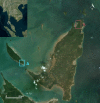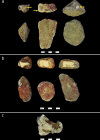Group-specific archaeological signatures of stone tool use in wild macaques
- PMID: 31635691
- PMCID: PMC6805154
- DOI: 10.7554/eLife.46961
Group-specific archaeological signatures of stone tool use in wild macaques
Abstract
Stone tools in the prehistoric record are the most abundant source of evidence for understanding early hominin technological and cultural variation. The field of primate archaeology is well placed to improve our scientific knowledge by using the tool behaviours of living primates as models to test hypotheses related to the adoption of tools by early stone-age hominins. Previously we have shown that diversity in stone tool behaviour between neighbouring groups of long-tailed macaques (Macaca-fascicularis) could be explained by ecological and environmental circumstances (Luncz et al., 2017b). Here however, we report archaeological evidence, which shows that the selection and reuse of tools cannot entirely be explained by ecological diversity. These results suggest that tool-use may develop differently within species of old-world monkeys, and that the evidence of material culture can differ within the same timeframe at local geographic scales and in spite of shared environmental and ecological settings.
Keywords: ecology; long-tailed macaques; primate archaeology; primates; selection; stone tools; technology.
© 2019, Luncz et al.
Conflict of interest statement
LL, MG, TP, MS, LK, SM No competing interests declared
Figures









References
-
- Braun DR, Plummer T, Ditchfield P, Ferraro JV, Maina D, Bishop LC, Potts R. Oldowan behavior and raw material transport: perspectives from the kanjera formation. Journal of Archaeological Science. 2008b;35:2329–2345. doi: 10.1016/j.jas.2008.03.004. - DOI
-
- Braun DR, Harris JWK, Maina DN. Oldowan raw material procurement and use: evidence from the koobi fora formation. Archaeometry. 2009a;51:26–42. doi: 10.1111/j.1475-4754.2008.00393.x. - DOI
Publication types
MeSH terms
LinkOut - more resources
Full Text Sources

